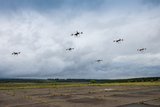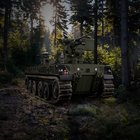Havoc UAS undertakes first flight
Brock Technologies has announced that its Havoc Unmanned Aircraft System (UAS) has undertaken its first flight on 24 October 2011. Brock Technologies made the announcement in a company statement, saying that the UAS will ‘bridge the gap between affordability and capability’.
The Havoc UAS was developed under a series of Air Force SBIR contracts. The twin boom, pusher 2-stroke engine platform was intended to provide users with a robust modular UAS capable of long endurance flights while carrying an assortment of payloads.
The test flight programme has so far seen the UAS undertake flights with two platforms with a variety of payloads. Swapping integrated forward payload bays between flights, Havoc successfully demonstrated video data transmission to the ground station, non-line-of-sight (NLOS) communications, Differential Global Positioning System (DGPS) functionality, and vehicle identification through a mode C transponder and blind encoder.
According to the company, the second series of flight tests is to take place in November, when additional capabilities and endurance testing will be carried out.
Built using advanced composite construction, the radio frequency transparent Havoc airframe structure offers multiple internal antenna placement locations that enable increased endurance and payload capability. With 1000 watts of power provided by the onboard generator at its disposal the Havoc can host a variety of payloads in either the forward or aft payload bay. The tails are also hollow and offer additional space for payload integration. Variable launch and recovery options continue to illustrate the systems modularity. The current prototypes have demonstrated successful rolling take-offs and landings. Future renditions will validate additional launch and recovery methods such as catapult launching and belly skid landing.
More from Uncrewed Vehicles
-
![US Navy foresees an uncrewed future for its surface and underwater fleet]()
US Navy foresees an uncrewed future for its surface and underwater fleet
The service has been conducting various procurement and development efforts to integrate unmanned surface and underwater vehicles into its inventory.
-
![Ready for the race: Air separation drone swarms vs. air defence systems]()
Ready for the race: Air separation drone swarms vs. air defence systems
As the dynamics of aerial combat rapidly evolve, Chinese scientists have engineered a sophisticated air separation drone model that can fragment into up to six drones, each capable of executing distinct battlefield roles and challenging the efficacy of current anti-drone defences such as the UK’s Dragonfire laser system.
-
![Israel’s MALE UAVs ‘must adapt’ to Iranian-made air defences]()
Israel’s MALE UAVs ‘must adapt’ to Iranian-made air defences
Advancements in air defence technologies have begun to reshape aerial combat dynamics in the Middle East, as illustrated by recent events involving the Israeli Air Force and Hezbollah.
-
![Hundreds more UAS sent to Ukraine forces with thousands more on the way]()
Hundreds more UAS sent to Ukraine forces with thousands more on the way
Both sides of the Russia-Ukraine war have been using UAS for effective low-cost attacks, as well as impactful web and social media footage. Thousands more have now been committed to Ukrainian forces.
-
![AI and software companies selected for US Army Robotic Combat Vehicle subsystems]()
AI and software companies selected for US Army Robotic Combat Vehicle subsystems
The US Army has intentions to develop light, medium and heavy variants of the Robotic Combat Vehicle (RCV) as part of the branche’s Next Generation Combat Vehicle family.

























